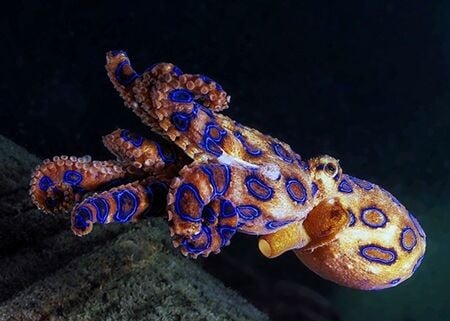Dangerous blue-ringed octopus found in seafood in Thailand

Seafood enthusiasts are urged to exercise caution as instances of the dangerous blue-ringed octopus found in food have been increasing, whether in barbecue restaurants, skewers prepared for grilling, or even sushi.
But why is this particular species a cause for concern? Let’s delve into the interesting yet perilous world of the blue-ringed octopus, a creature that is 20 times more venomous than a cobra, and learn how to identify it before consumption.
The blue-ringed octopus has recently been discovered in a local sushi restaurant, causing quite a stir. Similarly, customers were shocked to find the same species in a popular hotpot restaurant’s promotional offer for 99 baht per kilogramme. Another incident involved a young man suspecting the presence of a blue-ringed octopus in a seafood stall in the market, raising questions about the vendor’s sourcing practices.
The blue-ringed octopus, part of the giant octopus lineage, is a small species that can be found in both the Gulf of Thailand and the Andaman Sea. Its distinctive feature is a pattern of blue or purple rings that glow when threatened, set against a white or green body. This makes it one of the most beautiful octopuses, but also one of the most deadly.
The venom of the blue-ringed octopus is called Tetrodotoxin, similar to that of pufferfish. It can be found in the saliva, beak, tentacles, intestine, and ink sacs and directly affects the nervous system, leading to paralysis, respiratory failure, and potentially death.
The venom remains potent even after being subjected to heat, withstanding up to 200 degrees Celsius. Even 1 milligramme can be extremely dangerous. Remarkably, this venom is 1,200 times more potent than cyanide and 20 times stronger than cobra venom.
Symptoms of blue-ringed octopus venom begin with numbness around the lips and tongue, spreading to the face, arms, and legs, eventually leading to cramps. This is followed by nausea, blurred vision, loss of sensation, difficulty in speaking or swallowing, and finally, paralysis and respiratory arrest. Currently, there is no known antidote for the venom, and the only treatment is the use of artificial respiration and symptomatic treatment, reported Sanook.
Accidental consumption remedy
First aid for those affected by the venom involves providing oxygen, such as mouth-to-mouth resuscitation, and then rushing the patient to the hospital for artificial respiration. If successful, the patient can recover within 24 hours. However, prolonged oxygen deprivation can result in brain death, hence the best prevention is to avoid contact or consumption of the blue-ringed octopus.
To identify a blue-ringed octopus, look for a small body about 4 to 5 centimetres long and around 15 centimetres in length, with small blue reflective rings across its body and tentacles. This differentiates it from the Ika Ikue octopus, which only has one to two rings on its body and is safe to eat.
Latest Thailand News
Follow The Thaiger on Google News:


























